What We Offers
General Infectious Diseases
General infectious diseases are illnesses caused by harmful microorganisms like bacteria, viruses, fungi, or parasites. These microorganisms can spread from one person to another in a variety of ways. Here are some common methods of transmission, along with examples for each:
Direct Contact
Infections can spread through skin-to-skin contact or touching surfaces contaminated by an infected person.
Examples: The common cold, cellulitis (a bacterial skin infection), herpes simplex virus (cold sores or genital herpes), skin infections like impetigo, or staph infections.
Urinary Tract Infections (UTIs)
These occur when bacteria enter the urinary tract, often causing pain or burning during urination.
Example: E. coli is the most common cause of UTIs, which can lead to symptoms like frequent urination, lower abdominal pain, and fever.
Sexual Contact
Some infections are spread through unprotected sexual activity, including vaginal, anal, or oral sex.
Examples: Herpes simplex virus (genital herpes), HIV, chlamydia, gonorrhea, and syphilis.
Respiratory Droplets
When an infected person coughs, sneezes, or talks, they release droplets that can be inhaled by others nearby.
Examples: Influenza (flu), COVID-19, and the common cold.
Contaminated Food or Water
Consuming food or water that's contaminated with harmful microorganisms can lead to infections.
Examples: Salmonella, E. coli, or norovirus
Insect Bites
Certain insects can carry and transmit diseases when they bite or sting.
Examples: Malaria (spread by mosquitoes), Lyme disease (spread by ticks), and West Nile virus.
What We Offers
Specialities and Services
A newer preventive treatment using doxycycline, an antibiotic, to reduce the risk of sexually transmitted infections (STIs) like chlamydia, gonorrhea, and syphilis in at-risk individuals, particularly those engaging in high-risk sexual activity.
A type of bacteria resistant to many common antibiotics, often causing skin infections, pneumonia, or bloodstream infections.
Infections affecting bones or joints, typically after surgery, injury, or medical devices like joint replacements.
Infections occurring after surgery, such as at the surgical site or deeper tissue, requiring careful antibiotic treatment.
A life-threatening infection of the heart’s inner lining, often caused by bacteria entering the bloodstream.
A severe body-wide response to infection, causing inflammation and potentially leading to organ failure.
Infections that occur after organ transplantation due to immunosuppressive medications that weaken the body’s defenses.
A bone infection, usually caused by bacteria, which can occur after trauma or surgery.
A prolonged fever without an identifiable cause after extensive testing, often requiring specialist evaluation.
HIV weakens the immune system, leading to AIDS when untreated, making the body vulnerable to other infections.
Infections spread through sexual contact, including chlamydia, gonorrhea, and syphilis.
Infections caused by fungi, such as athlete’s foot, ringworm, or more serious systemic infections like histoplasmosis.
A bacterial skin infection that leads to redness, swelling, and pain, often on the legs or arms.
Viral infections affecting the liver, causing inflammation, liver damage, and increased risk of liver cancer.
A treatment where fluids, antibiotics, or other medications are administered intravenously outside of a hospital setting.
A bacterial infection of the colon, often caused by antibiotics, leading to diarrhea, abdominal pain, and potentially life-threatening complications.
An infection of the lungs, typically caused by bacteria, viruses, or fungi, leading to symptoms like cough, fever, and difficulty breathing.
A viral infection caused by the varicella-zoster virus, characterized by painful rashes and blisters, often along one side of the body.
A contagious respiratory illness caused by influenza viruses, leading to symptoms like fever, fatigue, and body aches.
A fungal infection caused by the yeast Candida, commonly affecting the mouth, genital area, or bloodstream.
Infections caused by mycobacteria, including tuberculosis and non-tuberculous mycobacteria, affecting lungs, skin, or other organs.
Strategies and practices aimed at preventing the spread of infections in healthcare settings, including hand hygiene, sterilization, and vaccination.
Medical care focused on preventing travel-related diseases, including vaccinations, advice on insect-borne diseases, and managing chronic conditions while abroad.
Infections affecting the skin and underlying tissues, such as abscesses, cellulitis, or infections from cuts, burns, or surgeries.
